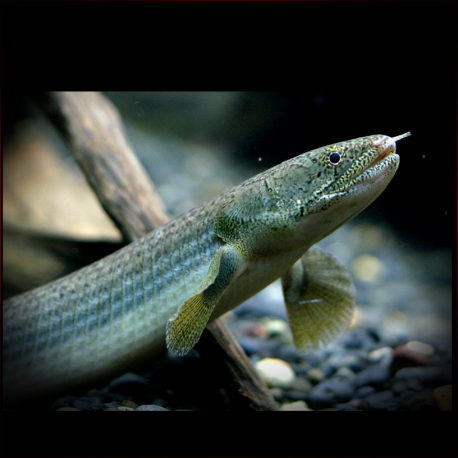More info
Datasheet
| Minimum Tank Size | 200 litres / 52.83 US gallons |
| Maximum Size | 35.0cm / 13.78inches |
| Temperature | 25°C / 77.00°F - 28°C / 82.40°F |
| Hardness | 5-25ºdH |
| pH | 6.0-8.0 |
General Description
The West African Bichir, also known as the Speckled Bichir, is a hardy and nocturnal species with poor vision, relying on its keen sense of smell for locating food. Belonging to the Polypteridae family, this ancient species dates back to over 200 million years. Notable adaptations include a divided swim bladder serving as an accessory breathing organ, amphibian-like external gills in young individuals, and the ability to survive out of water for a period if kept moist. Wild-caught specimens should be monitored for infections or parasites due to their frequent occurrence in captured fish.
Aquarium Setup
For the West African Bichir, a minimum tank size of 200 litres is recommended, prioritizing floor space over depth. An ideal setup includes a soft substrate, driftwood pieces, and smooth rocks for hiding spots. While plants are not mandatory, a secure, tight-fitting cover is essential to prevent escape as these fish are known for their adept escaping abilities.
Behaviour
This Bichir species is peaceful but should not be housed with tankmates that can fit in its mouth. Compatible companions include other Polypterus species, Synodontis, Datnoides, Knife Fish, larger Ctenopoma species, medium to large characins, and African Butterfly Fish. Their feeding behavior is primarily nocturnal, emerging at night to hunt small fish and invertebrates in shallow waters.
Feeding and Diet
Being carnivorous, the West African Bichir typically does not accept dried foods in aquarium settings, favoring live or frozen meaty options like prawns, earthworms, mussels, and lancefish. While some individuals may adapt to pelleted varieties, a diet rich in live or frozen foods is more suitable for their nutritional needs.
Reproduction & Dimorphism
Although breeding of this species is not commonly recorded in captivity, it is believed to follow patterns similar to other Polypteridae members. Breeding is induced by changes in water temperature and chemistry, with courtship involving chasing and nudging of the female by the male. Male Bichirs have thicker anal fins compared to females, and they are known to scatter eggs among vegetation after fertilization, with fry hatching in 3-4 days.
Habitat and Distribution
The West African Bichir is widely distributed across Western Africa, with documented sightings in nations like Nigeria, Cameroon, Ghana, and Congo Republic. These fish inhabit marshes, swamps, flooded regions, and small rivers, showcasing adaptability to various aquatic environments. Water parameters ranging from pH 6.0-8.0, hardness of 5-25°dH, and a temperature of 25-28°C are suitable for their habitat requirements.

